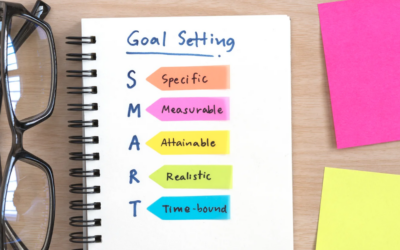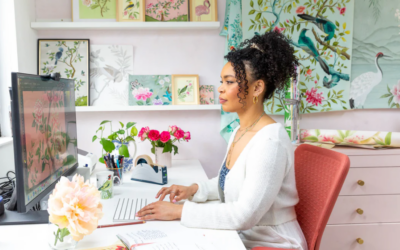No time to listen now? We'll send it to your inbox.
No time to listen now? We'll send it to your inbox.
or scroll down to get the highlights

Today we are (finally) diving into the world of Pinterest, where pins lead to profits. And nobody knows this better than Kate Ahl, the mastermind behind Simple Pin Media and host of the Simple Pin Podcast. I’m so excited to have Kate here today because, let’s face it, Pinterest has been a big mystery to many of us. But we’re in good hands, because there is no better expert on this topic than Kate.
Back in 2010, Kate was just like many of us—navigating the wilds of the internet with more enthusiasm than experience. With little kids at home and a need for some extra cash, she started helping a friend with Facebook and her website, diving headfirst into the digital arena. The world of social media and affiliate marketing grabbed her, and she was hooked by the vibrant online community and its endless possibilities.
Kate launched Simple Pin Media in 2014 with just three basic service packages aimed at content creators. It was supposed to be a three-month trial, but the results were undeniable. Clients reported transformative impacts on their businesses, leading Kate to the realization that she might just have a viable business on her hands.
Since then, Kate has dedicated herself to demystifying Pinterest marketing, making it accessible and not so overwhelming. She’s here to tell us that with a solid plan, anyone can conquer Pinterest (and maybe even enjoy it).
Exploring the Potential of Pinterest
Kate says that first and foremost, using Pinterest effectively is all about making sure people are aware that your product exists. It’s not just about throwing up a photo of your product and hoping for the best. You want to really engage your audience, help them understand what you’re selling, and educate them about it.
For instance, e-commerce owners who showcase their products effectively tend to be more successful. Say you’re selling jeans; showing different ways to wear them or comparing various styles can make a big difference. This approach doesn’t just build awareness; it educates your potential customers too. Simply posting lots of product photos without context tends to be ineffective because customers don’t understand why they should buy your product.
Take, for example, a handmade tile seller she works with. She knows that buying handmade tiles involves careful consideration and measurement, so her strategy on Pinterest focuses on inspiring and informing her audience, rather than pushing them to make a quick purchase. She aims to get her product samples into potential customers’ hands and raise awareness about current design trends. Her approach helps position her brand as a viable alternative to big-box stores like Home Depot or Lowe’s, making her a go-to choice for those in search of handmade tiles.
Ultimately, success on Pinterest comes from using strategies similar to what might be done on Google to educate and engage, rather than just listing products for sale. This is how you turn casual browsers into informed, interested buyers.
Key Elements Of An Effective Pinterest Strategy
When diving into Pinterest, remember there are three main elements you should focus on to make your pins pop:
Images: This is key because on Pinterest, the image is pretty much everything. You’ll want to nail both product shots and lifestyle images that showcase your products in a real-life context.
Keywords: Spend some time researching what people are actually searching for on Pinterest, which can be different from other platforms. For example, the terms “vegan” vs. “plant-based” might attract different audiences. It’s crucial to use the right keywords in your pin descriptions to tap into the correct search queries.
Pinning Strategy: Once you’ve got your pin with its perfect image and keyword-rich description, start pinning it across your boards. You don’t have to worry about overposting the same pin too frequently, because unlike Instagram, Pinterest isn’t about scrolling through someone’s profile. You can pin the same content to different boards at different times, even revisiting it months later. This approach works because Pinterest’s algorithm isn’t time-sensitive, and frankly, most Pinterest users won’t notice if you’ve pinned the same thing multiple times.
How to have a big impact on Pinterest in Just 2 Hours Per Week
Many of our students are hesitant to add another marketing channel because Instagram, Facebook, and TikTok already take up so much of their time and energy. But Kate says there are a few key areas that you should be dedicating your energy to, and they don’t need to take more than 2 hours a week.
Before you dive into pinning repeatedly, it’s crucial to set up your Pinterest profile correctly, mainly to make it algorithm-friendly. Start by setting up your boards—they’re like buckets for the algorithm to sort your content.
For example, if you’re selling jeans designed for pear-shaped body types, name your board accordingly and craft a clear description. This helps Pinterest understand exactly what type of content you’ll be pinning there, like it’s all about jeans for pear-shaped bodies.
Once your boards are ready, the next big task is creating compelling images, which are like billboard ads on Pinterest. Remember, people mainly look at images, not read through lots of text. For fashion items, less text usually works better, so focus on visuals that highlight the features of your jeans, like the fit or style details.
When you upload these images, either directly or using a scheduling tool like Tailwind or Planoly, you’ll want to ensure your keywords match the content of your board. This alignment helps Pinterest show your pins to users who are searching for those specific terms, enhancing the relevance and reach of your content.
Setting up a routine of creating great images and using the right keywords is essential. A scheduling tool can help spread out your pins over time, which reduces your workload. No need to constantly comment or follow others—the platform does much of the heavy lifting.
It typically takes about six months to see significant results on Pinterest. If you’re only a couple of months in and not seeing much activity, don’t get discouraged. It’s all about consistency. Keep feeding the algorithm with good content. Your pins from day one will eventually start getting attention, and before you know it, you’ll see a snowball effect: more engagement, more traffic to your store, and an increased interest in your products.
So, hang in there, keep pinning, and watch how your two-hour weekly investment gradually builds a robust presence on Pinterest.

Pinterest SEO: How To Find The Best Keywords
It’s important to remember that Pinterest is a visual search engine. Users are primarily looking for content that benefits them in some way, unlike Instagram where your followers are keen to see behind the scenes content, or personal posts from the business owner. If you’re good at SEO, you’re likely to excel on Pinterest too, although the approach to keyword research might vary a bit. Here’s how it works:
When you do SEO, you’re typically looking for keywords that Google favors. Well, you can start by plugging those same keywords into Pinterest. But in reality, Pinterest itself is the best tool for figuring out what works specifically on their platform.
When you enter your keywords on Pinterest, pay attention to the search predictions that pop up. These suggestions are gold because they show exactly what users on Pinterest are looking for. Sometimes, these keywords might differ from what you’d use for Google. So, even if a keyword works well on Google, you might find a more effective variation or a completely different popular keyword on Pinterest.
Essentially, Pinterest not only helps refine your keyword strategy but also tailors it to capture the most relevant Pinterest audience. So, stick with the keywords that resonate with the Pinterest crowd, even if they’re a bit different from your usual SEO terms.
Pinterest Marketing Metrics: What To Look For
How can you tell if your Pinterest strategy is actually working? There are three key metrics you should keep an eye on: impressions, saves, and clicks. Let’s break these down a bit:
- Impressions: This tells you how often your pin is shown. For example, if someone is scrolling on their phone, Pinterest might show two rows of pins. Your pin might be on the left, but if they’re looking at the right, they might not see it. However, having a high number of impressions means your pin is getting out there to a broader audience.
- Saves: This is a big one because when someone saves your pin, it shows they’re interested. Pinterest users typically browse through and save a bunch of pins they like. Later, they revisit their saved pins when they’re ready to engage further or make a decision.
- Clicks: This is what you ultimately want — people clicking on your pins to take a closer look or go to your website.
While Pinterest offers up to nine different metrics, focusing on these three will give you a solid indication of how well your content is performing. You can literally compete against yourself by tracking how your pins perform in terms of impressions, saves, and clicks over time. Adjust and test different strategies to see what makes your pins more save-worthy and click-worthy. Remember, it’s not always about creating brand-new content. Sometimes, tweaking what you already have can lead to better results.

What You Need To Know About Pinterest Ads
For store owners accustomed to getting quick results with Meta and Google ads, Pinterest ads can feel a bit slow to kick in because they need about two weeks just to run without any interference. This pause lets Pinterest figure out the best way to distribute them. You’ll spend another two weeks just collecting data to see what’s working, totaling a month of prep and observation. This can be a shift for those used to the quicker pace of Facebook ads, and the different dashboard and reporting style on Pinterest might also take some getting used to.
If you’re new to Pinterest ads, Kate suggests dedicating at least a month to learn the ropes, maybe through a membership program that guides you through the process. After about two months of learning and preparing, you should start to see your ads perform well.
And here’s a fun tip: try experimenting with low-cost Promoted Pins, like a dollar a day, to see how they perform without much risk. This can be a great way to learn what resonates with your audience without the pressure. You might find that even these small investments can give you decent visibility, which is always a win. Plus, playing around with promoted pins and different types of Pinterest ads can help demystify the process and make it more enjoyable.
Pinterest Is NOT Social Media
Pinterest, like Google and YouTube, is used by people who are actively trying to solve a problem. They might visit your site, decide it’s not what they’re looking for, and keep searching until they find the right solution. The key is to make sure your site can meet their needs when they land there, making you the solution they’ve been searching for.
To capture their interest, you need to quickly convince them they’re in the right place—for example, confirming they’ve found the right plant-based skincare product they were looking for.
A common mistake is directing these users to a homepage when they’re expecting a specific product page. This mismatch can frustrate users because they don’t want to search again—they want immediate solutions. Pinterest users often take longer to make a decision because they’re looking for the perfect answer to their needs.
Want To Work With Kate?
Kate’s agency Simple Pin Media offers a few different ways for people to work with them, depending on their needs and how hands-on they want to be.
First off, they handle both organic and paid Pinterest ads directly for clients who prefer to take a hands-off approach. For those who want to be more involved, they offer a “done with you” service which includes membership options. This is great for people who want to learn how to manage their own Pinterest ads but with some guidance from Kate’s team. It’s a pretty affordable membership that lets you get your hands dirty without going it alone.
They also have a DIY option through their Shopify store. Since Pinterest is friendly towards digital products, they’re set up to sell things like e-commerce templates for Canva and other resources directly through Shopify. This setup is perfect for folks who want to integrate what they sell with their Pinterest activities.
For those already running ads but looking to optimize, she offers specific resources like Pinterest ads templates that you can grab and use right away.
So, whether you’re looking to fully outsource your Pinterest marketing, get some guidance while doing it yourself, or just grab some tools to make your life easier, Simple Pin has a solution for you.
RELATED LINKS:
Check out https://juleptile.com/ on Pinterest for a great example of how a successful eComm store uses Pinterest
See the Simple Pin Shopify Store: https://simplepinshop.com/
Learn more about Pinterest services and training: https://www.simplepinmedia.com/
Listen to The Simple Pin Podcast: https://www.simplepinmedia.com/simple-pin-podcast/
Get my new course, Conversion School for Free!
Learn our step by step process to grow your sales, without spending a
fortune on risky ad strategies, or discounting your products
The strategy you’ll learn in Conversion School works for Ecommerce stores at all stages.
You'll use your store’s data, so if you’re starting out, you’ll learn how to get consistent sales.
Established Store Owners will learn how to achieve significant sales growth every month.
A Little Trick To Get The Results You Really Want, Episode 225
No time to listen now? We'll send it to your inbox. No time to listen now? We'll send it to your inbox. or scroll down to get the highlightsHow to Set the Right Goals and Achieve Clarity in Your Business Recently,...
From 0 to multiple 6 figures. The story of a creative success, Episode 224
No time to listen now? We'll send it to your inbox. No time to listen now? We'll send it to your inbox. or scroll down to get the highlightsI get this question all the time: can artists and creatives really earn an...
How Erica supersized her profit and wiped out her stress, Episode 223
No time to listen now? We'll send it to your inbox. No time to listen now? We'll send it to your inbox. or scroll down to get the highlightsHow Erica Campbell Turned Her Faith-Based Gift Shop Into A Profitable Business...



